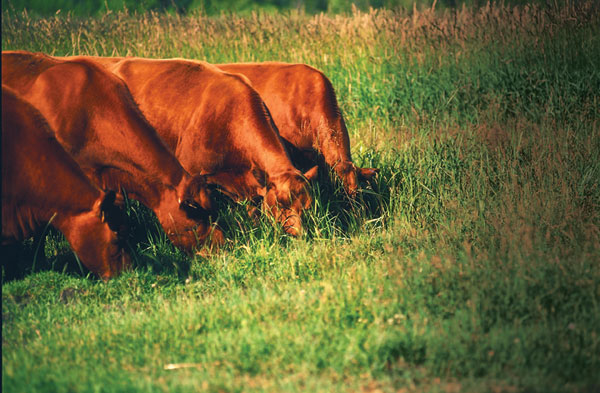Minerals Matter – Introduction to mineral nutrition
Don’t skimp on your mineral program. Adequate mineral intake can solve a myriad of production problems.
July 30, 2020

Although their percentage of the diet is small, minerals pack a big punch in the beef cattle herd. Producers seeking solutions to poor pregnancy rates, weak newborn calves or other reproductive or performance issues should not overlook a thorough review of their beef herd mineral program. Often, deficiency in minerals surfaces as a factor influencing the health and nutrition of the beef animal.
“We are always learning more about what minerals can do and learning more about the basic needs of beef cattle nutrition,” Stephanie Hansen, Iowa State University beef feedlot nutrition specialist, told cattlemen during a webinar series on mineral nutrition hosted by NCBA. She noted minerals matter because they are important to the overall animal health, along with bone and muscle growth, feed efficiency, carcass quality, and reproductive performance. To develop the proper mineral nutrition program it is important to know the two main types of minerals associated with beef cattle diets: macro minerals and micro-minerals.
Macro minerals
“Macro-minerals are usually less than 1% of the diet, but are very important,” Hansen explained. Common macro minerals are calcium (Ca), magnesium (Mg), phosphorus (P), and sodium (Na). Since beef animals cannot store macro minerals in their body, these minerals must be provided in a constant supply through the animal’s diet, either from feedstuffs or supplements.
Fortunately, forages supply macro minerals, meaning cattle grazing grasses have access to these critical minerals. Research indicates the ratio of calcium to phosphorous in the diet should be 1:1.
While many nutrient needs are met through forage consumption, a common misnomer is that grass tetany occurs in the spring because the grass is low in magnesium levels. This is not true, Hansen said.
The magnesium deficiency which causes grass tetany is the result of interference of other minerals in the grass, creating a decrease in absorption of magnesium at levels needed. The main culprit of this interference is potassium (K), which tends to be represented at high levels in forages in the spring, thus preventing the animal from obtaining the required magnesium levels and forcing producers to supplement the beef animal’s diet with a mineral high in magnesium, correcting the shortfall.
“The rule of thumb is a potassium to magnesium (K to Mg) ratio of 10:1. Nitrogen regularly used to fertilize grass and forages is also capable of creating interference with absorption levels of magnesium.”
Micro nutrients (trace minerals)
The other primary family of minerals important to beef cattle diets is micro minerals, more commonly referred to as trace minerals. “Fed at levels as parts per million (ppm), trace minerals are a very, very small part of the diet, yet cattle can still be deficient in these minerals, impacting productivity,” said Hansen.
Top of mind for cattlemen are copper (Cu) and zinc (Zn), as these two trace minerals are often deficient in forages. Unlike macro minerals, the ruminant can store trace minerals in their body to be utilized later, thus alleviating the need for access to the constant intake of trace minerals.
“Where monitoring of trace minerals becomes important is due to their great variability in forages.” However, one trace mineral abundant in forages and harvested feedstuffs is iron (Fe). Iron is commonly found at levels two to three times higher in forages than needed to balance nutritional requirements.
The concern with iron is its role as an antagonist. Iron acts as a buffer against some of the other critical trace minerals, such as copper and manganese, preventing them from being absorbed and utilized at levels to maintain proper cattle health and nutrition.
Finding the balance
The nutrition specialist is often asked, “Can cows balance their diets when their body indicates a deficiency in a mineral?” Unfortunately, the answer is no.
“Research has found that cattle will select a palatable but poor-quality diet in preference to an unpalatable, nutritious diet,” she said, “requiring constant management practices to focus on herd nutrition.” Salt has become the primary intake driver in most free choice minerals to add palatability to products and keep consumption levels up.
Following nutritional requirements is a good baseline, but “don’t assume the book averages apply in all cases.” Mineral content varies by plant species, soil characteristics, soil fertility, stage of plant maturity, and climatic conditions. To find minerals that matter to your cowherd, first test forages and second conduct water tests. Water can play the role of an antagonist in mineral bioavailability ̶ how much of the mineral the animal can absorb and use.
“No mineral is an island. You can’t just fix one problem; you need a holistic approach because a change in one mineral can mean a change in the other.”
B. Lynn Gordon is a freelance writer from Sioux Falls, S.D.
You May Also Like


.png?width=300&auto=webp&quality=80&disable=upscale)
